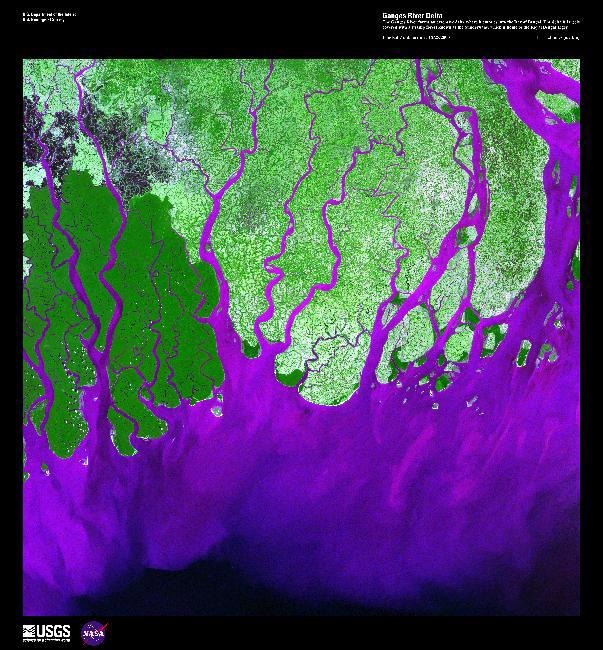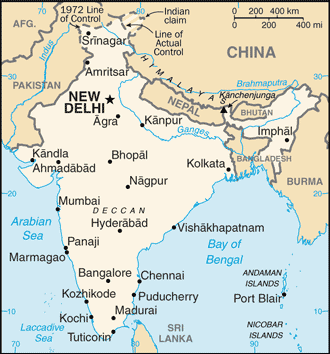Jul 21 2012
India is the seventh largest country in the world with an area of 3,287,263 km2. The country has a population of 1,365,377,132 as of 2019, so is the second largest in the world. It is located in Southern Asia, between Burma and Pakistan, with the Arabian Sea and the Bay of Bengal bordering its peninsula. India’s climate varies from tropical monsoons in the south to a temperate climate in the northern regions.
 |
| The national flag of India. Image Credits: The CIA Factbook |
India was under colonial rule for centuries, thanks to its vast wealth of natural resources. The major impact of this long-term colonization was a stagnant economy. Nevertheless, the Indian economy has seen rapid development in the past few years. However, the country is yet to achieve its major goal of eliminating rampant corruption, overpopulation, and poverty.
The GDP of the country is $411.905 billion as per March 2019 estimates. The country’s mineral mining sector forms the backbone of its industrial production. About 2.2% to 2.5% of India’s GDP is contributed by its mining industry.
The following sections will discuss in detail India’s natural resources, mining industry, and its outlook for the future.
Overview of Resources
India has vast and rich mineral and metallic reserves. The total mineral production reaches around US$ 17.62 billion, increasing by 13% in 2017-18.
In 2010, the following were the value of exports and imports of ores and minerals:
- The total value of exports of ores and minerals - $27.6 billion
- The total value of imports of ores, minerals, and fuels - $113 billion
- Diamond (mostly cut) – 66.2%
- Iron ore - 22.2%
- Granite - 3.9%
- Alumina - 0.75%
- Crude petroleum - 69.7%
- Precious and semi-precious stones – 0.78%
- Diamonds (uncut) - 14.2%
- Coal - 7.5%
- Copper ore and concentrate - 3.6%
- Natural gas - 2.1%

A false-color satellite image of the Ganges river showing a large amount of sediment (violet), from the Himalayas precipitating as it encounters the sea. Image Credits: The CIA Factbook
The following table shows the mineral commodities India is self-sufficient with:
| Metals |
Minerals |
| Bauxite |
Barite |
| Chromite |
Dolomite |
| Ilmenite |
Feldspar |
| Iron Ore |
Limestone |
| Manganese Ore |
Sillimanite |
| Rutile |
Talc |
Industrial Minerals
India is the largest exporter of cut and polished diamonds in the world. Diamond mining in India dates back to the 5th century. In 2017-18, the country’s annual exports of cut and polished diamonds were worth $23.7 billion. Nearly 40% of Indian diamonds are procured by the United States, 4% are procured by China and 7% is used domestically. India’s gems and jewelry market size is expected to reach $100 billion by the year 2025.
Cement consumption in India continues to increase by 10% every year. The country increased its cement production capacity by 50 Mt/yr in 2010, which adds up to a total of 300 Mt/yr. Some of the major cement manufacturers in the country include Shree Cement Ltd., with a capacity of 1.2 Mt/yr, and The Associated Cement Cos. Ltd, with a capacity of 1.8 Mt/yr. The increasing demand for cement and power industries aids the growth of metals and mining. Demand for iron and steel are also increasing.
India’s major graphite producer is Graphite India. It accounts for a capacity of approximately 12.6% of leading global graphite electrode manufacturers.
India has been increasing its electrode production steadily in the past few years due to low-cost operations. The electrode demand is also driven by the production of steel.
Metals
India exported nearly 120 Mt/yr of iron ore in 2010, of which 75% was shipped to China. The country’s iron ore comes mainly from the states of Goa, Karnataka, and Orissa. India is the ninth-largest steel exporter in the country. Its highest markets are the countries Nepal, Italy and Belgium. In 2018, the steel trade surplus was at 1.3 million MT.
India has the world’s seventh largest bauxite resources (about 8% of the world bauxite is produced in India) and has about 841 known deposits with nearly 3,300 Mt of bauxite. Most of these deposits are located in the northeastern peninsular belt and southern and central India. HINDALCO, Nalco and Vedanta are the country’s major aluminum producers.

A map of India. Image Credits: The CIA Factbook
India is a net exporter of refined copper. Copper is mined from local mines and its concentrates are also imported due to the low-grade quality of domestic copper. Hindustan Copper Limited (HCL), Hindalco Industries Ltd and Vedanta Limited are the major copper producers in India.
India is one of the major importers of manganese ore in the world. The reserves/resources of manganese ore in India as of 2015 are at 495.87 million tonnes. The leading manganese ore producing state in India is Madhya Pradesh, followed by Maharastra and Odisha. Nearly 60 to 65% of this ore is used for manganese alloy production. It is an important material in iron and steel metallurgy.
Fossil Fuels
Coal, a fossil fuel, is vital for sustainable development. Commercial coal mining has occurred in India since 1774, with the nationalization of coal mines happening in 1973. India‘s coal imports are increasing rapidly and account for 10% of the domestic consumption of coal. Problems with land acquisition, low investments, and social and environmental hurdles contribute to the shortage of coal in India. Nearly 388 Mt of coal was used for power generation in 2010. In 2011, the country’s coal shortage was expected to touch 104 Mt. Search for overseas assets and expansion of mines can help in enhancing coal availability in the country. India’s most important energy source until 2031-32 will be coal. The production of coal at 639.23 million tonnes in 2015-16 increased by 3.7% to 662.79 million tonnes in 2016-17. India was the third largest coal producer in the world in 2015.
A fifth oil well has been discovered in India by Reliance Industries Ltd. in Cambay basin in the State of Gujarat. The flow rate of the well is 255 barrels per day (bbl/d) of oil. Meanwhile, UK-based Cairn Energy Plc and India’s Oil and Natural Gas Corp. (ONGC) have started pumping oil from the Mangala field through the Barmer-Bhogat pipeline. The average production of the field was 60,000 bbl/d. and this oil was supplied to private refineries.
ONGC has formulated a pilot program for shale gas extraction and drilled its first well in the Burdwan District in the State of West Bengal. The company intends to drill three more shale gas wells in the Damodar basin in the States of Bihar and West Bengal.
Investment
India has adequate resources of many important minerals and metals and the country is emerging as an open-market economy. Economic liberalization measures, which include privatization of state-owned enterprises, industrial deregulation, and reduced controls on foreign investment, have aided in the rapid growth of the country.
India’s bauxite and alumina production are likely to increase thanks to some mine expansion plans by Nalco and also Utkal’s refinery expansion plans. The country is also planning to import more emerald, uncut diamond, and other precious and semiprecious stones in order to meet the increasing demand in the domestic gemstones industry. A possible increase in demand for gems and jewelry from Europe and the US is expected to boost the export value by 25% or more. Impending expansions and upgrades of oil refineries will likely increase the country’s refining capacity of light and heavy crude oil.
The coal mining lobby in the State of Meghalaya has opposed foreign investment in the coal mining sector. The state government has planned to implement a mining policy that will regulate mining activities and resolve the environment, health and labor issues in the mining sector.
Recently, a committee of the government of Goa, which is the largest iron ore exporting state in India, has recommended a 20 to 25 million tonnes limit on iron ore extraction in the state. The state’s iron ore exports during the last fiscal year have come down considerably compared to that in the earlier financial year due to irregularities in its mining sector. Recent reports also suggest that India’s industrial production has recovered from a decline. According to the Central Statistical Office, the country’s production at factories and mines increased by 2.4% compared to the previous year.
Experts feel that India will continue to be largely self-sufficient in many mineral and metal resources and emerge as a leader in metal and mineral resources, provided it frames stringent policies to tackle its mining lobby and illegal mining activities.
Disclaimer: The Author of this article does not imply any investment recommendation and some content is speculative in nature. The Author is not affiliated in any way with any companies mentioned and all statistical information is publically available.
Sources and Further Reading
This article was updated on the 12th April, 2019.